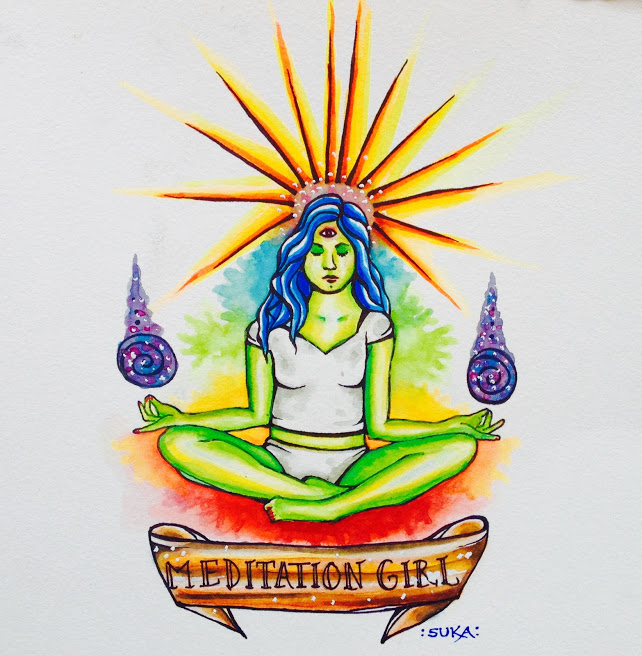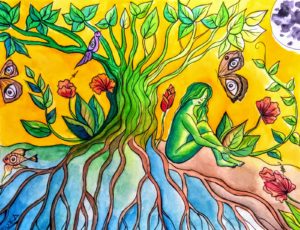The first time I saw them, they were yelling to the sky: “Hey Hey, Ho Ho!” They walked in a circle, hands high, hands low. “Hey Hey! Ho Ho!” A flock of birds flew overhead and without a word, they all stopped, their hands frozen in the air, and turned to watch the birds pass. This, I thought, is appreciation.
I had stumbled upon the Group of Elderly Yogis in the tiny park tucked inside neighborhood Jasola Vihar 2 in New Delhi, India. I approached, timidly, but with a giant smile. The woman teaching introduced herself in English–Mayu. She and her husband, Anil, told me I was more than welcome to come back.
“We’re here every day at 5:30! Until 7. Every morning,” Anil told me in crisp English.
“You’re more than welcome to come,” Mayu added, patting me on the back. “I’ll even bring an extra plastic sheet for you, to cover the grass.” She winked, and walked away. The others smiled and nodded, and a few came over to say hello. This was the same type of comfort I’d felt with my grandmother growing up, that acceptance the youth feel when surrounded by those who have lived much longer. With my grandmother, we’d laugh and make Danish meatballs and fry pancakes. Here, I felt accepted fully.
With old folks, I feel an invitation and a warmth. It’s as if there are legions of untold stories and pieces of wisdom gathered over a lifetime, balancing on the edge, waiting for someone to ask the right question. And I love asking questions.
That night, there wasn’t a doubt in my mind I would attend the next morning. I set my alarm for 5:10.
The air of New Delhi before dawn is calm. It has yet to be rustled awake by the tuk tuks and honking horns and the bumper car battles of the busy streets. Dawn is patient. Leaving my apartment, I walked the five minutes to the park, feeling sneaky as I maneuvered my way through the darkness. There hadn’t been many times in Delhi when I, a woman, had done things on my own. Though I’d never felt threatened, I was more aware of stares, and just more attuned to identifying as woman, a gender that is a minority in the city, in the country. But this morning, I was invisible. I felt the swell of anticipation warm me.
I walked over to the group, a shadow of bodies in the waning night. Mayu had brought a plastic sheet and mat, already set up. I sat down, and practiced the art of following. Though there were some words in English–clockwise, “counterwise”, right, left, other–most of the words were spoken in Hindi. I learned what sounded like “rishna” or “ruah,” meaning relax. We did that often.
As we moved through the poses, each movement was syrup slow and intentional in the way that only older people can stretch. So many other yoga classes I’ve attended, in the States or Ecuador or Costa Rica and even in India, had felt like an unwanted invitation to a competition. In those moments of stretching myself too far, the intention transformed from a desire to love my body deeper to a need to prove my body’s openness. Here, with this group of people ages 60 and up, I was within a different community. These are people who practice yoga not for the exercise, the competitive sweat; rather, they practice out of need and out of respect.
When we went to our backs and stretched a leg up and over to the other side, someone passed gas loudly. There wasn’t a single giggle.
I found myself attuned to this moment, this philosophical fart.
Rather than pretending he hadn’t, or chuckling afterward as if to apologize, there was just acceptance. The purpose of these poses is to release the gas and tension built into the intestines. Farting in the morning is one of the best releases. I sent a loving message to my own intestines–do your thing, gastroworld. Clean it all out.
As we continued, I realized that this class was unlike any other for another reason: everyone was a teacher. Mayu began, soft and intentional in her poses. Then, the man in the purple shirt: militaristic, strict, unsmiling. Then, the older woman who spent much of her time in child’s pose. Then, the green bean of a wily man, stretching his arms up for tree. It was silent, shared orchestration of poses, and I realized I would be invited to participate.
After many poses, we broke into mantras. Have you ever done a mantra in a different language, without practicing it? I hadn’t. I tried to mimic the words, but it felt cheap, my Americanness butchering the accent. I didn’t know what was being said. So, I invented my own.
Forests are for us, and mermaids that guide us, and all of the light that’s within. Come walk with me, guide me and gift me, all of the love, my friend.
No joke, I sang of mermaids and forests during these mantras, muttering under my breath, wondering which was more incorrect–copying Hindi sounds or creating my own Americanized version of the words. Regardless, it felt unifying. I looked up after, and Mayu was staring at me.
“You’re next!” She nodded. Nervous to lead folks who had been doing yoga for longer than I’d lived, I did something simple: two leg poses that I’d learned in Rishikesh a week before. Simple ways to open the hips. Everyone followed me, the newcomer, and after my poses, another man took over. As we finished, we rubbed our palms together until they became hot and placed them over our eyes. We exhaled, stood. It was Anil’s turn to lead, and we formed the laughter circle I’d witnessed the day before.
We began with a “tribal walk,” so dubbed by Anil, and chanted “Hey Hey, Ho Ho,” as we moved in tandem. Next, we symbolically milked cow’s udders, dripping invisible milk into our open, laughing mouths.
“This is the milkshake!” Anil calls out, emphatically squeezing udders from the air. “Now, let us see one another,” he said. We looked at each other and gestured, “Hey Hey, Ha Ha” from person to person, making hand motions, passing the words like a basketball. We connected eyes, smiled, and yelled our blessings. “God bless him, God bless her, God bless youuuuuu!”
Finally, we stood in a circle, and closed out our practice. Anil shared some of his prodigal words of wisdom. I could tell this moment, his soapbox sharing of philosophical truths, was why he attended these classes. He was a man meant to be a professor, searching for students wherever he could.
“During our days,” he began, “When people come to us from a place of stress or worry or anger, do not respond in such a way. Instead, just laugh. Like the waves, imperfectly flowing back and forth. Don’t let anything stop the laughter.”
The group nodded the collective nod of folks who had heard the same message many times before–perhaps every morning–but I absorbed fully, the mind of a new pupil. I parted with the promise that I would return.
And I did, a second time. A third. On my last class, Anil turned to me during the closing circle and asked, “What would you like to share with us?”
I turned to the anticipatory faces of the group, men and women whose names I still didn’t all know, but whose favorite poses had become part of my mornings. I shared a quote I’d read by Annie Dillard.
“How we live a day is, of course, how we live a life.”
I talked about my own small attempts to meditate on this quote, to pass it on to my students. At the end of my minute long speech, everyone, in unison, clapped their hands and said, “Very good! Very good!”
Leaving the circle on my last day, preparing to fly out to South Africa in the afternoon, I finally spoke to the man in the purple shirt, the commanding officer. I told him I’d be getting on a plane in just a few short hours. He listened to me as I spoke, and when I finished, he shook his head back and forth, and smiled.
“In India,” he began, “We don’t live sideways. We get married, have kids, have a job, work, and die.”
He didn’t say it in a way that was condemning; he didn’t say it in a way that was condoning. He stared at me for a bit, a small smile of the grandfatherly trope on his lips. He was, perhaps, trying to unriddle me, this wandering American flying from country to country, working for an organization and doing this professionally. He stared for a few seconds, and, I believe, found the answer he was looking for in my eyes. He nodded his head, and walked off toward the other end of the park.
In India, we don’t live sideways. It stays with me, this line, months later. Living sideways exists in opposition to another pathway. Without forward, there would be no backward; without left, there would be no right. Without straight, there would be no sideways. I don’t think one way is better than another, living straight or living sideways. Certainly, they all come with their fair share of questioning. But all ways of living invite unplanned joy, these chances for growth. Like the farting poses, and the laughter circles and the invisible milkshake making in the sky, we don’t have to be living sideways in order to see these small moments as gifts. We just have to be living with our eyes wide open.





